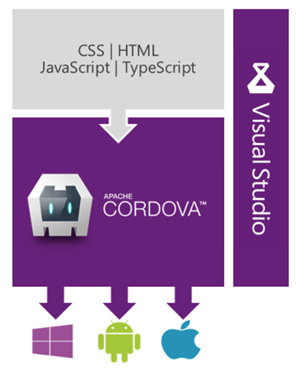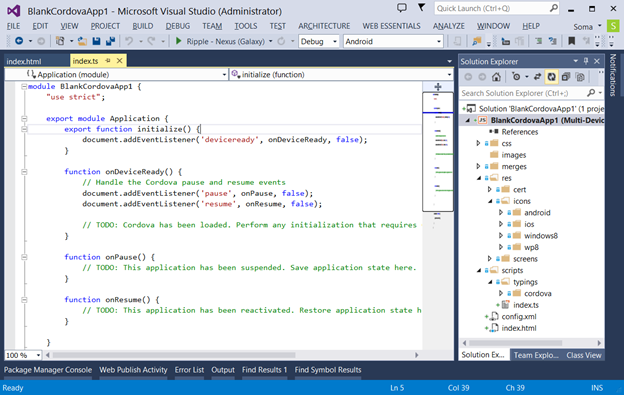
At its TechEd North America 2014 conference today, Microsoft made a long list of announcements for developers regarding its various tools and technologies. Among the highlights are the release of Visual Studio 2013 Update 2 with improved tools for Windows Phone 8.1 and Microsoft Azure, tooling support for Apache Cordova, and ASP.NET vNext preview, but the company also launched a multitude of smaller additions that play into its vision for cross-platform mobile development and cloud-optimized Web development.
Visual Studio
First up, Visual Studio 2013 Update 2 has been released, bringing new features as well as tools for Windows Phone 8.1 and universal Windows apps. Visual Studio 2013 has already seen over 5 million downloads to date. The biggest highlight in Update 2 is that Microsoft’s promised to let developers create universal Windows apps from one single project is now a reality.
Microsoft supports three UI frameworks for universal Windows apps (XAML, HTML and DirectX), giving developers the choice of writing the app in C#, JavaScript, and C++. As such, developers can now:
- Install a single set of developer tools to target the full range of Windows devices with Universal Projects support in Visual Studio 2013.
- Create universal Visual Studio Solutions using XAML and .NET, or using HTML and JavaScript.
- Leverage APIs that can be used across the platforms supported by universal Windows apps, but still customize to apps to particular device type to take advantage of device-specific capabilities or special tailoring.
- Deliver applications for multiple devices using the same application model.
Microsoft wouldn’t say what’s coming in Update 3, but Brian Harry, the company’s Corporate Vice President of the Developer Division, did tell TNW that work has now begun. The only major missing piece of the puzzle is Xbox support, so that’s what we would put our money on.
Visual Studio Online
Visual Studio Online, Microsoft’s cloud-based application lifecycle management offering, has been extended with the release of new APIs and service hooks providing integration points to third-party services. This makes it easier for organizations to adopt Visual Studio Online without abandoning the tools they’re already using today, and naturally allows Microsoft’s tool to become both richer and more specialized.
Today, 18 partners are showing off their offerings. These include AppHarbor, Applitools, Apprenda, AppVeyor, ClearBlade, eDev Tech, Flowdock, Kato, LeanKit, MyGet, Perfecto Mobile, SendGrid, SourceClear, Tasktop, UserVoice, VS Anywhere, Zapier, and Zendesk.
The company also announced the OpsHub TFS to Visual Studio Online Migration Utility, which lets teams using TFS on-premises to migrate their most commonly requested data including source code, work items, test cases, and test results to their Visual Studio Online account. As for what’s next, Harry did tell TNW Active Directory support is coming.
Apache Cordova
Next, Microsoft has released a preview of Visual Studio tooling support for Apache Cordova, an open source platform for building multi-device hybrid mobile applications using HTML, CSS, and JavaScript. Most notably, Cordova includes support for Android and iOS, as well as support for Windows and Windows Phone thanks to Microsoft’s contributions to the project.
Microsoft lists five advantages for developing these hybrid apps:
- Code Editor: These app take advantage of all the code editing features in Visual Studio such as IntelliSense, syntax highlighting, and many other features are available for HTML, CSS, JavaScript or TypeScript web projects.
- Building UX: Multi-Device Hybrid App interfaces can be built using various open-source front-end frameworks such as Angular, Bootstrap, Backbone, Underscore, and WinJS (samples will be made available at TechEd).
- Debugger: Set breakpoints, inspect performance issues, analyze memory usage, and perform other debugging and diagnostics tasks on Android 4.4 and Windows Store.
- iOS – Remote Agent: A remote agent can be used on a Mac to enable building for iOS right from Visual Studio. The agent can also launch the iOS Simulator on the Mac.
- Integrating with Services: Microsoft services that speed up development for mobile apps can be integrated into these apps through the Service Manager and NuGet.
The Cordova tools in Visual Studio support end-to-end development of cross-platform mobile applications, meaning Web developers can use their existing skills to create hybrid packaged apps for multiple devices while still taking advantage of each device’s capabilities. In fact, Microsoft is offering templates for both JavaScript and TypeScript to provide a standard blank Cordova starter project. Developers can pick their HTML/JavaScript framework of choice, including Backbone and jQuery UI, Angular.js and Bootstrap, or WinJS.
Projects can be built, deployed, and debugged directly in Visual Studio against a variety of devices, device emulators, and Web-based mobile simulators. The default option is to use the Apache Ripple simulator to test your application in the browser before deploying to a device.
That being said, the preview also supports attaching the Visual Studio debugger to Ripple as well as a local emulator or a device. In other words, you can stay in Visual Studio while debugging your JavaScript and DOM layout running on an Android 4.4 device.
Microsoft seems most excited that developers will be able to use Visual Studio to develop, test, and launch a Cordova app directly on an Android device or iOS device. The company isn’t hiding that its goal is to turn Visual Studio into the best tool for creating multi-device apps across Android, iOS, Windows, and Windows Phone. Microsoft already offers the option of native apps powered by .NET and Xamarin, but now it is also pushing into the world of standards-based development provided by the Apache Cordova platform to further its push for helping build apps that share a large amount of code across devices.
ASP.NET vNext
ASP.NET vNext is the next form of ASP.NET, as its name implies, but it’s optimized for the cloud. It has much richer layering, so an app can carry only the pieces it needs. Currently, every app has to use the same version of ASP.net that is available on a given Windows machine, but Microsoft wants to change the completely.
Here are five facts the company wants to underline about the successor:
- It’s a streamlined framework and runtime that is optimized for cloud and server workloads.
- It lets ASP.NET developers leverage their existing skills and create applications with automatic cloud support built in.
- It enables a more agile web development, with full side-by-side support per application and dynamic compilation based on the new .NET Compiler Platform.
- It provides a flexible componentization as well as best of class performance and startup times.
- It will be part of the .NET Foundation as an open source project (including all the libraries from the lowest level all the way to UI frameworks), and will run across multiple platforms through a partnership with Xamarin.
Everything developers know about ASP.NET will still apply to ASP.NET vNext (you won’t have to rewrite your app), but the next version will be a collection of packages with each application describing its dependencies. Best of all, developers will be able to make changes to their Web applications and see the results on a browser refresh, with no compilation needed (this is thanks to the new .NET Compiler Platform “Roslyn”).
.NET
On top of Microsoft’s .NET Foundation initiative announced last month, the company today shared some additional details about .NET on the server: its goal for the next version of .NET will be to make it the first framework designed for the cloud. In other words, it will be aimed at helping developers create on-premises applications and move them to the cloud without requiring any changes.
Microsoft’s reasoning is simple. A cloud-optimized .NET would reduce the footprint of the framework by removing libraries that developers don’t use in server applications. As such, the whole framework could be deployed with the application, meaning you can upgrade on an app-by-app basis as well as run different versions side-by-side.
Best of all, Microsoft says it is developing the next version of .NET (it’s not clear whether the company will call it .NET 5.0 or something else entirely) with cross-platform in mind for teams working in mixed development environments. It is actively collaborating with Xamarin to ensure that cloud-optimized .NET applications can run on OS X and Unix on top of the Mono runtime.
APIs, Libraries, and other tidbits
Microsoft has also made available custom client libraries for developing against the Office 365 APIs released in preview earlier this year. They are available both for C# and Xamarin, and for JavaScript and Cordova.
Next, Microsoft has given MSDN subscribers virtual machine images for Windows 7 and Windows 8.1 in the Azure VM gallery. These images, which build on top of the Visual Studio 2013 images already in the gallery, make it even easier to develop and test Windows client applications in the cloud on Azure.
Microsoft also announced further enhancements to its DevOps portfolio. Customers can now use PowerShell Desired State Configuration (DSC) with an initial set of scripts to help ease configuration, automation, and management of on-premises and Azure VM-based cloud infrastructure.
As the company known for courting developers, Microsoft may have outdone itself, yet again. We’ll keep you posted about any other news that comes out of TechEd.
Top Image Credit: Eric Piermont/Getty Images
Get the TNW newsletter
Get the most important tech news in your inbox each week.








